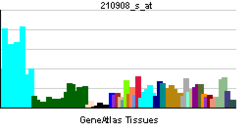PFDN5
| PFDN5 | |||||||||||||||||
|---|---|---|---|---|---|---|---|---|---|---|---|---|---|---|---|---|---|
| Identifiers | |||||||||||||||||
| Aliases | PFDN5, MM-1, MM1, PFD5, prefoldin subunit 5 | ||||||||||||||||
| External IDs | MGI: 1928753 HomoloGene: 1972 GeneCards: PFDN5 | ||||||||||||||||
| |||||||||||||||||
| RNA expression pattern | |||||||||||||||||
  | |||||||||||||||||
| More reference expression data | |||||||||||||||||
| Orthologs | |||||||||||||||||
| Species | Human | Mouse | |||||||||||||||
| Entrez | |||||||||||||||||
| Ensembl | |||||||||||||||||
| UniProt | |||||||||||||||||
| RefSeq (mRNA) | |||||||||||||||||
| RefSeq (protein) | |||||||||||||||||
| Location (UCSC) | Chr 12: 53.3 – 53.3 Mb | Chr 15: 102.33 – 102.33 Mb | |||||||||||||||
| PubMed search | [1] | [2] | |||||||||||||||
| Wikidata | |||||||||||||||||
| View/Edit Human | View/Edit Mouse |
Prefoldin subunit 5 is a protein that in humans is encoded by the PFDN5 gene.[3][4][5]
This gene encodes a member of the prefoldin alpha subunit family. The encoded protein is one of six subunits of prefoldin, a molecular chaperone complex that binds and stabilizes newly synthesized polypeptides, thereby allowing them to fold correctly. The complex, consisting of two alpha and four beta subunits, forms a double beta barrel assembly with six protruding coiled-coils. The encoded protein may also repress the transcriptional activity of the proto-oncogene c-Myc. Alternatively spliced transcript variants encoding different isoforms have been described.[5]
Interactions
PFDN5 has been shown to interact with Myc.[4][6]
References
- ↑ "Human PubMed Reference:".
- ↑ "Mouse PubMed Reference:".
- ↑ Vainberg IE, Lewis SA, Rommelaere H, Ampe C, Vandekerckhove J, Klein HL, Cowan NJ (Jul 1998). "Prefoldin, a chaperone that delivers unfolded proteins to cytosolic chaperonin". Cell. 93 (5): 863–873. doi:10.1016/S0092-8674(00)81446-4. PMID 9630229.
- 1 2 Mori K, Maeda Y, Kitaura H, Taira T, Iguchi-Ariga SM, Ariga H (Dec 1998). "MM-1, a novel c-Myc-associating protein that represses transcriptional activity of c-Myc". J Biol Chem. 273 (45): 29794–29800. doi:10.1074/jbc.273.45.29794. PMID 9792694.
- 1 2 "Entrez Gene: PFDN5 prefoldin subunit 5".
- ↑ Fujioka, Y; Taira T; Maeda Y; Tanaka S; Nishihara H; Iguchi-Ariga S M; Nagashima K; Ariga H (Nov 2001). "MM-1, a c-Myc-binding protein, is a candidate for a tumor suppressor in leukemia/lymphoma and tongue cancer". J. Biol. Chem. United States. 276 (48): 45137–45144. doi:10.1074/jbc.M106127200. ISSN 0021-9258. PMID 11567024.
Further reading
- Hansen WJ, Cowan NJ, Welch WJ (1999). "Prefoldin-nascent chain complexes in the folding of cytoskeletal proteins". J. Cell Biol. 145 (2): 265–277. doi:10.1083/jcb.145.2.265. PMC 2133115
 . PMID 10209023.
. PMID 10209023. - Cowan NJ, Lewis SA (2002). "A chaperone with a hydrophilic surface". Nat. Struct. Biol. 6 (11): 990–991. doi:10.1038/14870. PMID 10542082.
- Rommelaere H, De Neve M, Neirynck K, et al. (2001). "Prefoldin recognition motifs in the nonhomologous proteins of the actin and tubulin families". J. Biol. Chem. 276 (44): 41023–41028. doi:10.1074/jbc.M106591200. PMID 11535601.
- Fujioka Y, Taira T, Maeda Y, et al. (2002). "MM-1, a c-Myc-binding protein, is a candidate for a tumor suppressor in leukemia/lymphoma and tongue cancer". J. Biol. Chem. 276 (48): 45137–45144. doi:10.1074/jbc.M106127200. PMID 11567024.
- Watanabe K, Ozaki T, Nakagawa T, et al. (2002). "Physical interaction of p73 with c-Myc and MM1, a c-Myc-binding protein, and modulation of the p73 function". J. Biol. Chem. 277 (17): 15113–15123. doi:10.1074/jbc.M111281200. PMID 11844794.
- Strausberg RL, Feingold EA, Grouse LH, et al. (2003). "Generation and initial analysis of more than 15,000 full-length human and mouse cDNA sequences". Proc. Natl. Acad. Sci. U.S.A. 99 (26): 16899–16903. doi:10.1073/pnas.242603899. PMC 139241
 . PMID 12477932.
. PMID 12477932. - Simons CT, Staes A, Rommelaere H, et al. (2004). "Selective contribution of eukaryotic prefoldin subunits to actin and tubulin binding". J. Biol. Chem. 279 (6): 4196–4203. doi:10.1074/jbc.M306053200. PMID 14634002.
- Ota T, Suzuki Y, Nishikawa T, et al. (2004). "Complete sequencing and characterization of 21,243 full-length human cDNAs". Nat. Genet. 36 (1): 40–45. doi:10.1038/ng1285. PMID 14702039.
- Gerhard DS, Wagner L, Feingold EA, et al. (2004). "The status, quality, and expansion of the NIH full-length cDNA project: the Mammalian Gene Collection (MGC)". Genome Res. 14 (10B): 2121–2127. doi:10.1101/gr.2596504. PMC 528928
 . PMID 15489334.
. PMID 15489334. - Bruneel A, Labas V, Mailloux A, et al. (2006). "Proteomics of human umbilical vein endothelial cells applied to etoposide-induced apoptosis". Proteomics. 5 (15): 3876–3884. doi:10.1002/pmic.200401239. PMID 16130169.
- Hagio Y, Kimura Y, Taira T, et al. (2006). "Distinct localizations and repression activities of MM-1 isoforms toward c-Myc". J. Cell. Biochem. 97 (1): 145–155. doi:10.1002/jcb.20619. PMID 16173081.